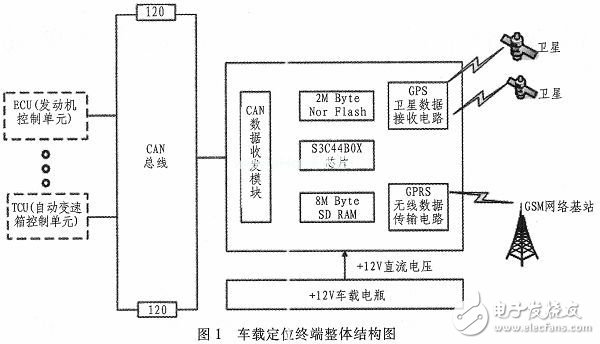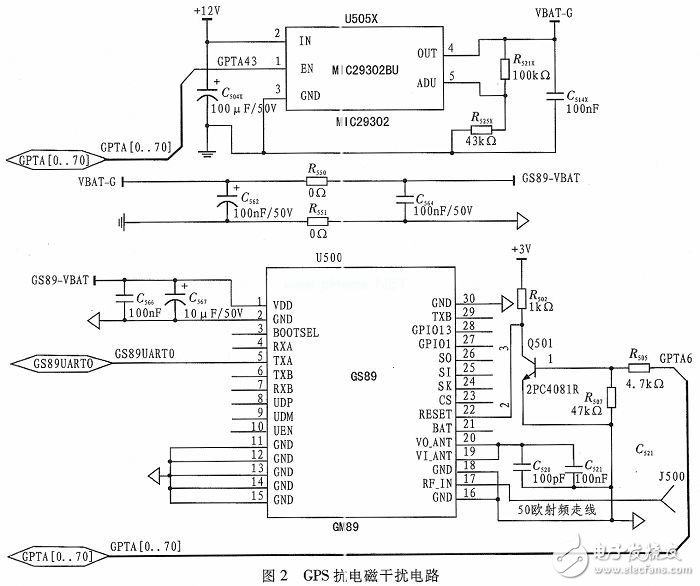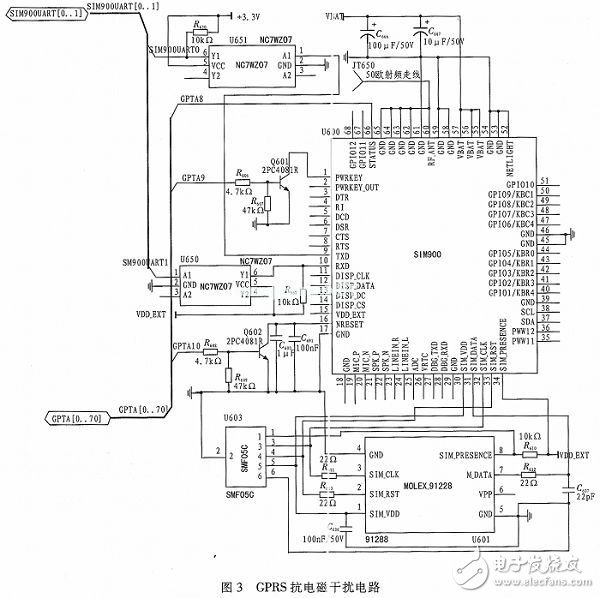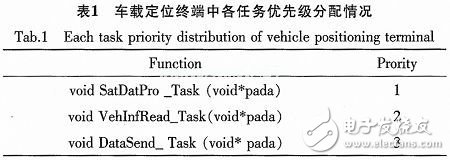In order to achieve the goal of saving energy and reducing emissions, electronic control technology has been rapidly developed and applied in diesel engines for trucks, engineering vehicles and agricultural vehicles. With the development of locomotive electronic control technology, the data acquisition and interaction speed and stability of the vehicle positioning terminal have become an important indicator to measure the equipment. In order to further improve the real-time performance and stability of the vehicle positioning terminal, an on-board positioning terminal based on ARM processor and μC/OS-II operating system is designed. The ARM processor is used to realize the high speed of data interaction, and the μC/OS-II operating system is applied to solve the stability problem of program running.
1. Introduction to the overall structure and function of the vehicle terminal
The vehicle positioning terminal is mainly composed of CPU (including S3C44BOX chip, 2MbyteNorFlash and 8MByteSDRAM), GPS satellite data receiving circuit, GPRS wireless data uploading circuit, CAN controller and data transceiver module. As shown in Figure 1: +12 V DC from the vehicle battery passes through the voltage conversion circuit on the vehicle positioning terminal, and converts the DC power of +5 V, +4.2 V and +3.3 V to the CAN data transceiver module of the vehicle positioning terminal. S3C44BOX chip, GPS satellite data receiving circuit and GPRS wireless data transmission circuit power supply; CAN data transceiver module receives data of reaction electric control vehicle working condition sent by ECU, EGR, TCU and other vehicle controllers through CAN bus, two at the end of CAN bus The 120 ohm resistor is an impedance matching resistor; the GPS receives the satellite data in real time and outputs the data to the CPU according to the NMEA-0183 protocol; the CPU receives the data transmitted by the CAN data transceiver module through the response mechanism, and receives the GPS in real time through the interrupt mode. The data is processed by the corresponding algorithm, and then all the data is packaged and sent to GPRS according to a fixed format; after receiving the corresponding data packet, the GPSR is uploaded to the monitoring center in real time through wireless.

In the practical application of the vehicle positioning terminal, the main factors affecting the data interaction speed depend on the processing speed of the CPU, the reading of the electronic control vehicle condition information and the real-time reception of GPS satellite data; the main factor affecting the stability is the hardware. Anti-electromagnetic interference performance and reasonable scheduling allocation of different priority tasks by μC/OS-II operating system. The following will elaborate and analyze several major influencing factors such as CPU circuit, GPS satellite data receiving circuit, GPRS wireless data uploading circuit and system software.
2, the design of the hardware circuit
1) S3C44BOX processor
The S3C44BOX processor is a 16/32-bit RISC processor from Samsung that uses the ARM7TDMI core. The processor has a wealth of built-in components: 8KBcache, LED controller, SDRAM controller, 5-channel PWM customizer, PLL multiplier, IIC bus interface, IIS bus interface, 2-channel UART, 4-channel DMA and 8-channel 10-bit AD converter. These components allow the S3C44BOX processor to deliver high performance while operating at up to 66 MHz, minimizing design development costs. Compared with the traditional 8-bit single-chip microcomputer, the S3C44BOX processor can greatly improve the data processing speed of the vehicle positioning terminal.
2) GPS anti-electromagnetic interference circuit
As shown in Figure 2, the core device of the GPS circuit is the GS-89M-J module. The module uses the latest MTK3329 chip as the main control chip, the positioning accuracy is less than 10 m circumferential error, and the positioning time is only 1 s in the hot start mode. The MIC29302BU module is a high current and high stability voltage regulation module. It is mainly used to supply 4.2 V working voltage to the GS-89M-J module. The 5 pin in the module is an adjustable output pin. In the adjustable mode. This pin outputs a fixed 1.25 V DC voltage. In order to ensure that the module can provide a stable 4.2 V voltage, the design uses a precision resistor R521X and R525X with resistance values ​​of 43 K and 100 K to form a series voltage boost circuit. To output the 4.2 V DC voltage on the output pin of the module, the S3C44BOX controls the operation of the module by outputting a high level or a low level to the 1 pin (EN terminal - enable output, active high) of the module. Whether or not; the ground separation circuit composed of capacitor C564, polar capacitor C562, resistor R550 and R551 is mainly used to isolate the GPS circuit from other circuits on the vehicle terminal to prevent the GPS circuit and other circuits from being coupled due to common impedance. Cross-interference; in order to ensure the stability of the vehicle positioning terminal operation, a general-purpose I/O pin of the S3C44BOX chip and a transistor Q501, a resistor R502, a R505, and a R507 constitute a GS-89M-J reset control power. Road, to ensure that the master chip can reset the GS-89M-J in time when the program is running; the impedance of the GPS antenna selected in this design is 50 ohms, because the GPS signal is 1575. 42 MHz In the transmission process, the carrier signal is easily reflected by the characteristic impedance of the transmission line and the terminal impedance. To prevent this phenomenon, the RF line for connecting the GPS antenna and the RF_IN pin of the GS-89M-J module in this design is prevented. The characteristic impedance value is 50 ohms; the GS-89M-J module receives the signals from the satellites in real time and solves them, and packs the solution results into GPGGA, GPGSA, GPGSV, GPRMC, GPVTG and GPGLL7 frame data according to the NMEA0183 protocol. Output to the S3C44BOX. The S3C44BOX receives the data frame sent by the GS-89M-J in real time through the serial port interrupt mode.

3) GPRS anti-electromagnetic interference circuit
As shown in Figure 3, the core device of the GPRS circuit is the SIM900 module. The SIM900 is designed with power-saving technology and consumes only 1.0 mA in sleep mode. At the same time, the module embeds the TCP/IP protocol, which improves the development efficiency of the user's application of the module for wireless data transmission. The NC7WZ07 in the circuit is a high-speed level conversion chip, which can convert the 4.2 V serial signal output from the SIM900 into a 3.3 V serial signal that can be received by the S3C44BOX, enabling the unobstructed communication of the SIM900 and the S3C44BOX; MOLEX- in the circuit 91228 is a SIM card holder. In order to prevent the SIM card from being interfered by electrostatic discharge and high-frequency signals, the SMF05C is used to protect the SIM card. To prevent the UHF signal from the SIM900 from being reflected to the SIM card, the signal reflection is reduced. Signal quality, here select 22 ohm resistors R614 and R613 for impedance matching; S3C44BOX can send a high level of 1 s to the SIM900 1 pin (PWRKEY pin - electrical switch pin) Control the module to be turned off and on; the S3C44BOX can reset the module by sending a high level to the SIM pin 14 pin (NRESET pin - low level reset pin); like the GPS circuit, the GPRS circuit The characteristic impedance of the RF line used to connect the GPRS antenna to the SIM900 RF_ANT pin is 50 Ω; the SIM900 receives the data packet from the S3C44B OX through the serial port and uploads the data packet to the monitoring center via the GPRS network.

3, system software design
In order to realize the real-time performance and operational stability of the vehicle-mounted positioning terminal data, it is ensured that the electronic control vehicle working condition information reading task and the GPS satellite data receiving task can be completed in the first time. This design introduces the μC/OS-II operation. system. μC/OS-II can dynamically switch tasks according to the priority of the task to ensure the real-time requirements of the system.
As shown in Figure 4, the system main function flow chart, the system is powered on, after the S3C44BOX clock circuit and related register configuration complete the S3C44BOX initialization operation, and then call the OSInit () function to complete the μC / OS - II initialization operation, Then the system creates the application task of the vehicle positioning terminal through the OSTaskCreate(void(*task)(void*pd), void*pdata, OS_STK*ptos, INT8U prio) function, and finally starts the task scheduling function OSCtxSw() by the OSStart() function. Task scheduling. Synchronization and data interaction between application tasks is accomplished through semaphores and message mailboxes.

Based on the main functions of the vehicle positioning terminal, the vehicle positioning terminal application mainly includes three tasks and two interruptions. They are the Void VehInf Read_ Task(void*pada), which is mainly used to receive information on the working condition of the reaction vehicle from the on-board controllers such as ECU and EGR, such as: engine Coolant temperature, engine lubricating oil pressure, engine crankshaft speed, engine camshaft speed, exhaust gas aftertreatment valve opening, etc., because the vehicle positioning terminal must receive data from multiple vehicle controllers at the same time, to ensure that the vehicle positioning terminal can accurately identify The data uploaded by each vehicle controller, here uses the call-response mechanism to realize the data communication between the vehicle positioning terminal and each vehicle controller; the GPS satellite data processing task (void SatDatPro_Task(void*pada)) is mainly for GS-89M. The data frame transmitted by the -J module is filtered and the information of the vehicle location is extracted from the filtered data frame; the GPRS data upload task (void DatSend_Task(void*pada)) mainly uses the vehicle condition information and the location information according to the fixed data. The frame format is packaged and uploaded to the monitoring center wirelessly via SIM900; CAN receives the interrupt function (void_irq) CANRev(void)) is triggered by the CAN transceiver. When the CAN transceiver receives a frame of data from each onboard controller, the interrupt is triggered. The interrupt function mainly transmits the received data frame to the message through the message mailbox. The control status reading task of the control vehicle; the serial port receiving interrupt function (void_irq Seri Rev(void)) is mainly triggered when the GS-89M-J completes the satellite signal solving and outputs data to the serial port of the S3C44BOX.
The main factor affecting the real-time performance of the vehicle positioning terminal is the processing speed of the GPS satellite data. Therefore, the priority assignment of each task in the vehicle positioning terminal is as follows (the smaller the priority value, the higher the priority).

4 Conclusion
The vehicle positioning terminal designed in the paper uses ARM processor and μC/OS-II operating system to ensure the real-time performance and stability of terminal data exchange. It has been confirmed that the vehicle positioning terminal has broad application prospects in the fields of trucks, engineering vehicles and agricultural vehicles.
High Frequency Transformer,High Voltage High Frequency Transformer,High Requency Transformer Used For Machine,High Power High Frequency Transformer
Guang Er Zhong(Zhaoqing)Electronics Co., Ltd , https://www.cnadaptor.com